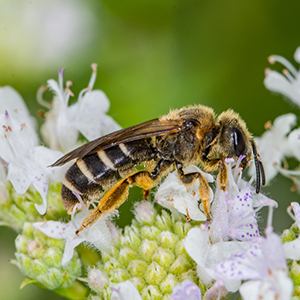The Curious Beekeeper
Who’s That Pollinating My Garden

It happens to nearly every beekeeper. You plant an array of flowering plants — from annual poppies to honeysuckle vines to crabapple trees — all tenderly selected to entice your darlings to forage. On the first balmy spring day, you watch your bees missile out of their hive and into the blue, but when you stroll through your garden, there’s not a honey bee in sight.
As you walk among your plantings, wondering where your bees went, you catch sight of the imposters — insects flitting from blossom to bloom, doing what your girls ought to be doing. But who are these guys? All you can say for sure is they’re not honey bees.
Learning how to identify the pollinators in your garden is no easy task. Even those who’ve spent years learning can have difficulty nailing it down without a dissecting scope and a teetering pile of reference books. What makes it so difficult?
Honey Bees are Outliers
Keepers of honey bees seem to be particularly confused about other species, and the reason is simple. Honey bees are outliers in the bee world, meaning many of the things you’ve learned about honey bees do not pertain to other bees in your garden. Even though all bees basically do the same thing, they do it in different ways.
For starters, let’s look at seasonality. You see your honey bees on the first flying day of spring to the last flying day of fall and every day in between. But other bees are different.
In spring and summer, adult bees have a life span of about four to six weeks. This holds true for just about any species. But since honey bees live in a colony that persists from year to year, bees that die are continually replaced by a busy queen. However, most wild species emerge at a particular time, reproduce during their allotted four to six weeks, and then die. Since their offspring won’t emerge until the following year, the species disappears from your view.
Different species begin to emerge at different times of year. Some appear in February, March, April and so on throughout the season. They do their reproductive thing, then disappear. From a human standpoint, that means the assortment of bees in your garden is different in April than it is in June or August. In fact, if you inventory the bees in your garden every single week, each successive week will look slightly different from the one before.
The Limits of Foraging Distance
Then too, many of the wild species have very short foraging ranges. Mason bees (genus Osmia) may fly 200 to 300 feet at most. Compare that to a honey bee who, when push comes to shove, can cover five miles or more. Among other things, that means that your neighbor may have an entirely different selection of bees, some that never enter your yard. And certainly the list of California girls is different from the roster of Jersey girls.
Time of day matters, too. Some species forage early in the day, and some forage late or even at twilight. Some wait for the air to warm, some go to shelter when the sun gets too hot. Climate matters. Altitude matters. Flora matters. Simply put, the bees in your garden are the ones suited to your particular microclimate. And when that microclimate changes, the bees change along with it.
Hazards to Identification
Then there is the difficulty of identifying bees, even when they hold still. Honey bees are drop-dead easy. Of all the bees in the genus Apis, only one species, Apis mellifera, is found in the western hemisphere.
Compare that to the mason bee genus Osmia. North America alone has more than 140 species of Osmia. Some of these can be distinguished with a good macro photograph. Others, perhaps most, need to be dissected and measured and compared with collected specimens. It turns out that the most telling parts of bees are the penis shaft and the mouthparts, both hard to see in a live bee, even if they were willing to drop their drawers or say “ahhh.”
And let’s not forget size. It’s hard to identify something you can barely see. The smallest bee in North America is about 2 mm long. In inches, that’s about one-sixteenth, or the thickness of a U.S. nickel.
Other Bee-Like Insects
Before you can identify a bee, you first need to eliminate the insects that are commonly confused with bees. Usually, that means flies and wasps. I have seen drone flies in the pages of bee magazines, on the covers of bee books, on bee websites, and in bee newsletters. It’s odd because, although these flies mimic honey bee drones and look somewhat similar, how often do you see drones foraging on flowers? You don’t. So foraging behavior should be a colossal hint. Remember, if you see a drone rummaging through the dandelions, look twice. Flies have stubby little antennae and do that hand-washing thing: easy peasy.
Wasps are harder to distinguish, but since they don’t collect pollen, they have little hair compared to bees. Male bees and cuckoo bees don’t collect pollen either, and ….


